GREEK HISTORY
 History of Navigation in the Aegean Sea
History of Navigation in the Aegean Sea
by Captain George Gritsis
The Aegean Sea was traditionally known as Archipelagos (in Greek, Αρχιπέλαγος, meaning "chief sea"), although in English this word's meaning has changed to refer to the Aegean Islands and, generally, to any island group.
The current Aegean coastline dates back to about 4000 BC. Before that time, at the peak of the last ice age (c. 16,000 BC) sea levels everywhere were 130 metres lower, and there were large well-watered coastal plains instead of much of the northern Aegean. The seawater level did continue to rise slightly during the classical period, as can be seen by the sunken ancient harbour of Paroikia (Paros) or the Lycian gravesites on the Asian Minor coast.
When they were first occupied, the present-day islands including Milos with its important obsidian production were probably still connected to the mainland. The present coastal arrangement appeared c. 7000 BC, with post-ice age sea levels continuing to rise for another 3,000 years after that. The very first vessels used for transport in the Aegean Sea were probably of the “papyrella” type, longboats made from bound reeds, and easily paddled to carry the strategic stone age material : the obsidian stone from Milos to all the adjacent areas. “Half papyrellas” were still used in a century ago in western Greece for coastal fishing (see illustration 1 & 1bis).
The subsequent Bronze Age civilizations of Greece and the Aegean Sea have given rise to the general term Aegean civilization. In ancient times, that sea was the birthplace of two ancient civilizations – the Minoans of Crete and the Mycenean Civilization (the Acheans) of the Peloponese.
The history of the Aegean ships and maritime trade does not have a concrete point of beginning. Its roots are lost in the depths of history. In a geographical area of which nowhere is more than 90 km away from the sea, from the Prehistoric Age the Greek populations developed in their majority coastal societies. In ancient times, navigation was easier than travelling across the rough terrain of the Greek mainland (and to some extent the coastal areas of Anatolia). The mountainous landscape of the mainland, the limited farming area and the extended coastline of Greece led people to seafaring. The geographical position of the region at the crossroads of ancient sea lanes in the eastern Mediterranean, the multiplicity of islands and the proximity to other advanced civilizations helped shape the maritime nature of the Greek nation at an early stage. The ever present northerly “Etesian”wind swiftly propelled trading ships back and forth between Asia Minor and mainland Greece, while North/South trading routes were possible mainly in the spring and fall when Southeasterlies and Southwesterlies are common. Harbours were few and ships were hauled on rollers ashore (safe from marine growth and worms) in sheltered bays. The rounded sterns and swinging steering boards made this operation easy. Waiting for the relentless northerlies to abate was common practice, Delos being a popular spot but also places like Aulis on the northern coast of Beotia as told in Euripidis’ classical play Iphigeneia (where Iphigeneia was sacrificed in order to appease the Gods and get the right wind to sail up North to Troy). Philip of Macedon was to make repeated use of the Etesian winds, campaigning during summer months, when the mighty Athenian navy would be unable to sail north and send assistance to his enemies.
Since the Cycladic period several pictorial evidences and shipwreck attested a large development of ships used both as men’o’war and merchantmen. These early Aegean ship were characterized by a lean long design and a long vertical bow with symbols mounted on top (see illustration 2). In the Greek mainland ships with the typical curved ram on the bow, are attested since the Middle Helladic period. Because of the intensive commercial trade between the Aegean population and the Near Eastern Kingdoms, some of the early Aegean ships show similarities in general shape and design with the Egyptian ships of the same period, as well attested in pottery representation and in the famous fresco from Akrotiri in the Thera island dated around 1600 BC. (see illustration 3).
Different type of Minoan ships in size and general design are well represented on several Seals, pottery, fresco and jewellery (see illustration 4 & 5). Some of The early Achaean ships were similar to Minoan ships, the later design was still characterized by the typic long lean design and a long vertical prow with symbols but with rams and platforms located in the stern and in the high stem. The largest of these ships could accomodate up to 50 oarsmen, the pentekontor. A large sail was also used, probably only when the wind was in the right direction. Sea battles represented on Greek pottery dated during the final phase of the Late Helladic periods seem related to these kind of large or medium size Achaean ships which are also attested in pottery/stone depictions, or askoi coming from Anatolian coastal settlements and islands.
All this exquisite maritime civilization was to come abruptly to an end. The explosion of the Thira (Santorini) volcano is one of the largest volcanic eruptions in recorded history: the Minoan eruption (sometimes called the Thera eruption), occurred some 3600 years ago at the height of the Minoan civilization. The eruption left a large caldera surrounded by volcanic ash deposits hundreds of feet deep and may have led indirectly to the collapse of the Minoan civilization on the island of Crete, 110 km (68 mi) to the south, through a gigantic tsunami. This theory is not, however, supported by chronology, in that the collapse of the Minoan civilization did not occur at the date of the tsunami, but some 90 years later. Rather, there seems to be evidence that it is the massive amount of volcanic ash from the eruption, with high sulfur content, which smothered the Minoan civilization.
As the Bronze Age Achaeans replaced the Minoans, they were faced with a major technological challenge: a new metal, iron, started trickling down the trade route from the Black Sea’s southern shores, where iron nodules were collected from dry riverbeds. This new metal greatly increased the efficiency of craftsmen, farmers and soldiers alike thanks to the sharper, stronger and lighter implements it allowed. The city of Troy at the entrance to the Dardanelles acted as a toll, controlling that trade and exacting high prices from the commerce in the new strategic material. It is no surprise that the seat of the mythic smith Hephaistos (Vulcan for the Romans), god of metallurgy, was the island of Lemnos the first greek port of call for the mineral laden ships, 30 odd NM south of Troy. Destroying Troy (see illustration 6) and getting unhindered and cheap access to the sources of iron and gold from adjacent Colchis (nowaday Georgia), was only a matter of time: Helen’s elopement was obviously just an other WMD ploy!
At the crossroad of aegean trade (see illustration map 7) lays the small island of Delos (near Mykonos) were from the earliest days, travellers and traders would wait for better weather before continuing their voyages. Investigation of ancient stone huts found on the island indicate that it has been inhabited since the 3rd millennium BC. Thucydides identifies the original inhabitants as piratical Carians who were eventually expelled by King Minos of Crete. By the time of the Odyssey the island was already famous as the birthplace of the twin gods Apollo and Artemis. The excellent harbours and all around protection at Delos (see picture of Archipel Club’s catamaran at anchor in Delos Hr) turned this small arid speck on the map into something equivalent to modern Singapore, while bearing, as well, enormous religious and cultural significance. Near the Greek sanctuaries, Egyptians, Phoenicians and Jews established their own temples. Massive rain water catchment reservoirs were built to support the ever growing population, while theaters and sports stadia entertained the 30000 estimated guests on the island. Every settlement in the Kyklades Islands with a direct view on Apollo’s Delos Sanctuary was called Apollonia, a place name that has survived today, even after 2000 years of Christianity.
These were times of expansion and the small greek trading vessels started shipping goods between the Eastern civilizations and newly established trading posts all the way to the Western Mediterranean, modern Morocco, Spain and France (see illustration 8 & 9).
The arrival of the Dorians in Greece, pushed numbers of Acheans to move out of the Peloponese and settle in Sicily and southern Italy (a.k.a. Magna Graecia). Later arose the city-states of Athens and Sparta among many others that constituted the Athenian Empire and Hellenic Civilization. Plato described the Greeks living round the Aegean "like frogs around a pond".
The merchant sailing vessels of the classical period carried goods all over the Mediterranean Sea and probably beyond. This was the time when Alexander the Great was advancing his troops to the East and Greek civilization were brought to contact with China via Western Asia and India for the first time. Recollections of Pytheas voyages to northern “Thule” suggest forays into the North Atlantic as well. The workhorse of the Greek trade is exemplified by the “Kyrenia Ship”.
The Kyrenia Ship is a Mediterranean trading vessel from around the 3rd century BC found in 30-meter-deep waters off the coast of Kyrenia on Cyprus in 1967. While ancient shipwrecks have been found all over the Mediterranean, nothing or very little of the ships themselves had survived. The Kyrenia ship was different, however. The unique circumstances that preserved it, owing to its load of amphorae under which a protective layer of sand kept a nearly complete merchant ship from destruction, have resulted in making it, to date, the finest preserved ship of the late Classical period of Greek civilization ever found. After 15 years of excavation and investigation by research teams from 12 countries, the ship was identified to be 14.33 meters long and 4.42 meters wide with a mast of about 11 meters height, weighing about 14 tons. (see illustration 13).
404 amphorae were found on the Kyrenia ship and it is known that this wine and olive oil from Samos, Kos and Rhodos were destined for Egypt. She had been built in the shell method of the times with the keel being laid down first then the hull and later the frames, fastened together by copper nails clenched over on the inner side – a medium size vessel with short decks in the bow and stern and an open cargo area between.
The shipbuilders had applied lead sheathing to the outer strakes to protect the hull against shipworm – a technique well-known to the Greeks. Spare sheets of lead were stowed on board for emergency patching. She had a moveable mast with a square sail (10.7 x 6m). Brailing lines (small ropes passing through pulleys used to haul up the sails) were fastened to lead rings. According to the weather or to balance the loads, the sailors could make adjustments by moving the entire mast and sail into different positions along the keel.
Greek war vessels of the iron age, such as the late pentecontor (50 oarsmen, see illustration 14 from ancient pottery) or the Athenian Triremes were the finest examples of shipbuilding (see pictures 15, 16, 17) of that time and inspired builders well into the next millenia.
However the uniqueness of the Athenian Trireme was its lightness, allowing tremendous maneuvrability and accelerations as a guided, ramming missile, thanks to the efficient rowing sytem of tightly packed rowers. This was possible only because oarsmen were not slaves but free citizen of the City who couldnot afford the (expensive) metal armour & weaponry of the hoplites but still had a duty to defend their homeland. Each Heretes (oarsmen) supplied his own oar and seat. Incidentally, the Trireme carried no soldiers and was intended for ramming only. The cheap, swift and nimble triremes having a clear advantage over cumbersome troop ships and with little means could finish off a mighty adversary before it could land his troops.
As the Greek city states lost political control of their sea to the Romans, a large part of the sea trade of the Roman Empire was still carried out by Greeks, who continued to be involved and play a major role in shipping during the Byzantine era as well, although the lucrative trades were increasingly falling in the hands of Venitians and Genovese.
During the Ottoman occupation that extended from the mid-15th century until the early 19th century Greece although loosing much of its importance remained active in sea-trading and continued building small and medium size vessels. They expanded their shipping activities and trade towards western Europe in the 16th century, taking advantage from the rapidly increasing need for grain. The restrictions imposed by the Ottomans to regulate the grain trade did not prevent the Greeks from carrying out illicit trade (using russian or british flags and registries) which brought considerable fortunes to them. Later, the Greek maritime merchants increased their influence, as they supplied the Balkans with raw materials, handled goods on behalf of foreigners, distributed the goods to the final markets and controlled the sea trade in the region, assuming the role of shipping agents. Lacking a maritime population, the Turks indentured a great number of Greek seamen in their war and trading fleets.
At the end of the 18th century sea-trade had made some Greek islands prosperous. Hydra, Spetsae, Psara, although small and arid had greatly benefited from the seamanship of its inhabitants and had raised an important fleet. Large vessels where ordered abroad, especially in French shipyards, smaller where still built locally (see illustration 18). The Napoleonic Wars and the blockade of the French ports by the English Navy was an important turning point in Modern Greek seafaring. Daring Greek captains repeatedly broke the English blockade and as a result amassed a great wealth. This helped building more, and more ships.
The contribution of the merchant fleets of Hydra, Spetsae and Psara during the independence war of 1821 against the Ottoman rule was decisive (see illustration 19). From the 700 Greek ships that where afloat at the beginning of the uprise, only 150 saw the end of the hostilities.
After the establishment of a Greek independent state in 1832, Greek seamen were prompt to adopt modern technologies; first the steam propulsion, then the construction of hulls made not of wooden planks but of riveted iron plates (see illustration 22). Ship-owners, who often were also the captains of their ship, from islands like Chios, Oinousses, Andros and Syros, were trading world-wide since the middle of the 19th century. But the islanders where also involved in numerous other maritime activities; besides fishing an example of lucrative activity was sponge-diving, which for nearly a century was an exclusive activity for the Kalymnians, Symians (see illustration 24) and in a smaller scale Hydriots.
The fact that nowadays the merchant fleet of Greece (flying the Greek flag or under other registries) has the largest (18%) tonnage in the world, is not solely due to the shrewdness of the Greek ship-owners, it is mainly the result of a long maritime tradition: that uninterrupted chain, that goes back to the dawn of history.
Sources
http://www2.egeonet.gr/forms/fLemmaBodyExtended.aspx?lemmaID=10594
Tzalas Charis, "Ships and seamanship of the Greeks", 2006
http://www.salimbeti.com/micenei/ships.htm
http://en.wikipedia.org/wiki
Over 60 years experience in crewed yacht charter in Greece
Our expert team by your side before and throughout your trip
Permanent crew
for constant boat maintenance
Credit card
secure payment
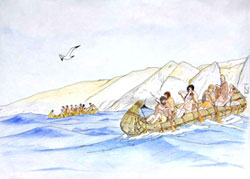
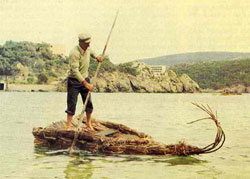
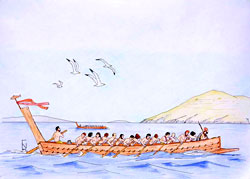
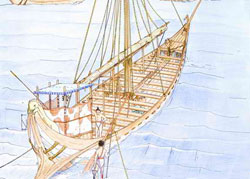



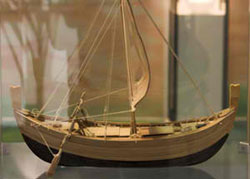
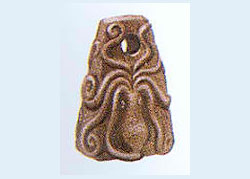
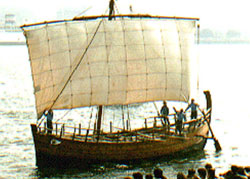
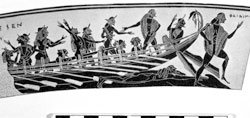
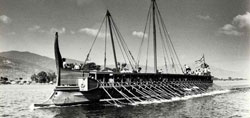
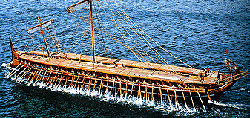
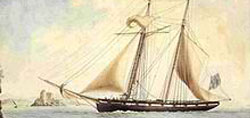
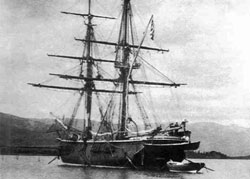
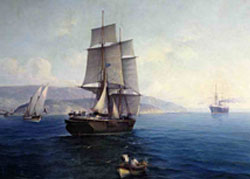
 History of Navigation in the Aegean Sea
History of Navigation in the Aegean Sea